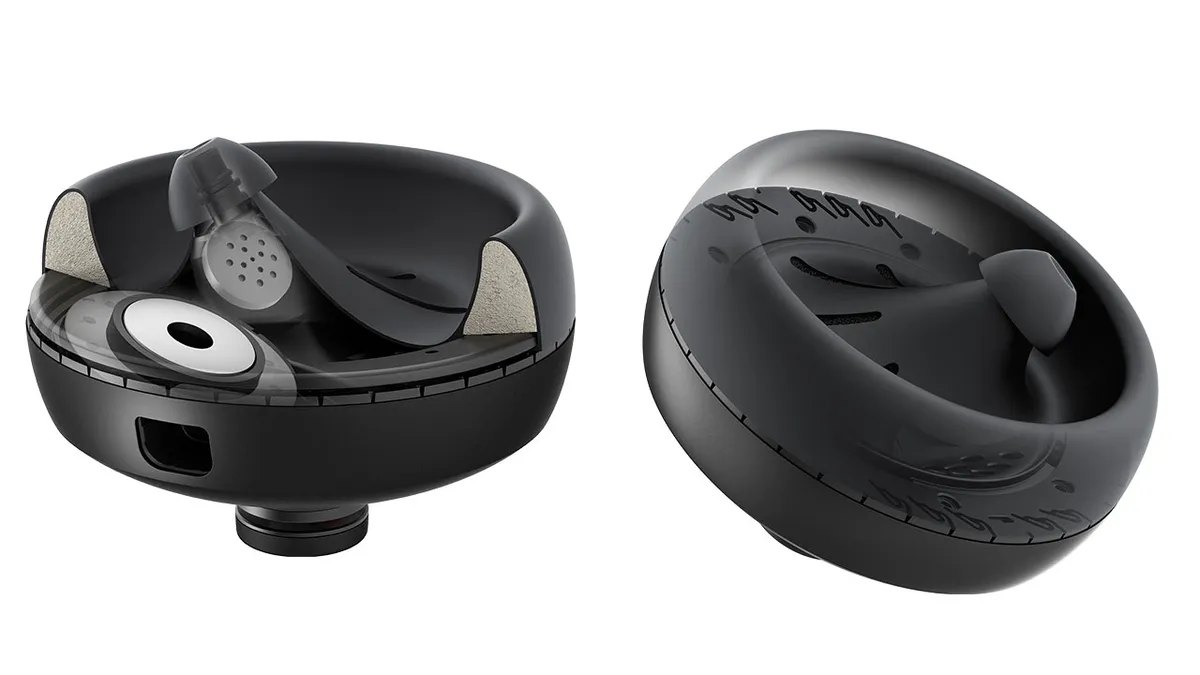The Nuraphones are something to be cherished: a genuinely new take on a piece of technology that’s been around for over a century. Nura’s pitch is that our ears are all different (just look at them), but headphones are all the same. They’re not talking about shape, but about our sensitivity to frequencies of sound (high vs low pitch). Traditionalheadphonesignore this, but the Nuraphones tests your hearing and configures your audio output to remedy any nuances in the way your auditory system perceives sound.
For example, I might be more sensitive to low pitch, bassy sounds, meaning that they tend to drown out anything in the treble spectrum. On an equaliser you might find me sliding up the treble. My partner meanwhile, could be more attuned to treble, finding my changes too tinny and lacking bass. The end result is that everyone’s perception of the music is slightly different.
Here’s the smart bit. The Nuraphones work by testing something called the Otoacoustic reponse. When you hear a sound, your inner ear (everything past the ear drum, more specifically the cochlea) actually makes a sound back. It’s a tiny, miniscule sound, but it’s a response from your inner hair cells – these are the tiny filaments that vibrate in response to sounds entering your ear, translating soundwaves into electrical signals that are sent to your brain. This Otoacoustic response is a measure of the condition of these vital hair cells, when they’re damaged you lose sensitivity to certain sound frequencies, sometimes we hear this as tinnitus. This test is most commonly used to test hearing in newborns, since it can measure your auditory sensitivity without words.
That, in part, explains the unusual design of the Nuraphone. To take a measurement of the Otoacoustic response, the headphones need two things: silence and proximity. The outer cup seals off noises from the outside world while the in-ear protrusion puts a hugely sensitive microphone close enough listen to your inner ear whisper its prescription. A microphone, by the way, that the headphone’s creators tell me has also been bought by NASA for use in their future Mars Missions.
Do they work?
The short answer is yes, it seems so. Turn on the app, put your name in, position the in-ear phone’s correctly and you’re greeted by the app: “hello Daniel”. A minute later, the hearing test is over and the headphones have stored your profile (you don’t need the app to make the headphone’s work, just to change between profiles). It then plays you a sample through the filter mapped from your unique hearing sensitivities. You can turn it on and off to hear the music with and without Nuraphone’s adjustments.
The effect is almost magic. You can tap your right earphone to cycle the filter on and off, and the difference is so compelling that I spent the week I had with the Nuraphones revisiting my music library. The sound just feels more nuanced, letting the more delicate elements of your music to shine through. It’s something akin to what happens when you wear sunglasses, you’re no longer blinded to the overwhelming amount of light and suddenly everything gains more clarity. Recordings feel more spacious. Since you’re more attuned to the audio’s levels you get a sense of space and direction, like the music’s being played in front of you. This effect is boosted by the headphones “immersion mode” which sends extra bass through the cans, rather than the in-ear speaker. This can turn the bass up so high that it actually shake the headphones on your head giving you a sort of haptic bass effect. Since it’s coming from a separate speaker it manages this without distorting the rest of the sound.

A cynic might question the starkness between the “with” and “without” filter modes. Standard headphones at the Nuraphone’s price range don’t sound as bad as the “off” setting on the Nuraphones might have you believe. Instead the real measure, in my opinion, of what the Nuraphones are doing is what happens when you try out other people’s aural profile. My partner’s audio was turned up massively in the treble range, it was like the album we were listening too – Pet Sounds – had been put through a magic mirror at a fun fair.
Tuned up
The Nuraphones started life as a Kickstarter project, developed in a dialogue with their first buyers. This means every design choice has been painstakingly considered. For a start, the packaging is compostable (made out of potato, actually). The materials used for the body and ear cups, from the brushed aluminium to the silicon cups have all been carefully selected to match the same matt black. Since they chose silicon for the ear cups, they built in a Tesla valve – a valve with no moving parts – to let cool air in and hot air out. The headphones feel light comfortable, and unlike a lot of recent headphones they favour form and function over style.
The company’s crowd-funders have also had a say in all of its features. There’s Bluetooth, every kind of cable needed included with the box and customisable touch sensitive controls on the headphones. There’s no active noise cancelling, but the isolation from the cups is good enough for most noisey situations other than a long fight. And there’s possibly more to come. As Nuraphones get to test more and more sets of years they’ll start to collect a bunch of data on our collective hearing. Who knows what they’ll learn, but they might actually be able to tell you if they start to notice any problems or worrying degradation in your hearing.
Technical specs
Price: £349,uk.nuraphone.com
Dimensions: 190 x 170 x 88 mm
Weight: 329 g
Connectivity: Bluetooth aptX HD, Universal Wired (Lightning, USB-C, micro-USB, analog)
Battery: Lithium Ion Battery, Up to 20 hours
Noise Isolation: Dual passive
Materials: High grade stainless, aluminium cups, hypoallergenic silicon pads
Voice: External microphones for calls
Verdict
The Nuraphones are a bold, original piece of tech that’ll make you rethink what’s possible. With these headphones on you feel like you’re being bathed in sound. We spent our week with the device listening to old albums over and over again and showing all our friends just how impressive they were; they’ll be sorely missed. Ultimately, since the sound tailor-made, it’s difficult to say how others will react to what Nuraphones are doing to your sound. But what I will say is that if you love music and consider yourself and audiophile then you ought to find a way to try out these brilliant headphones out for yourself.
